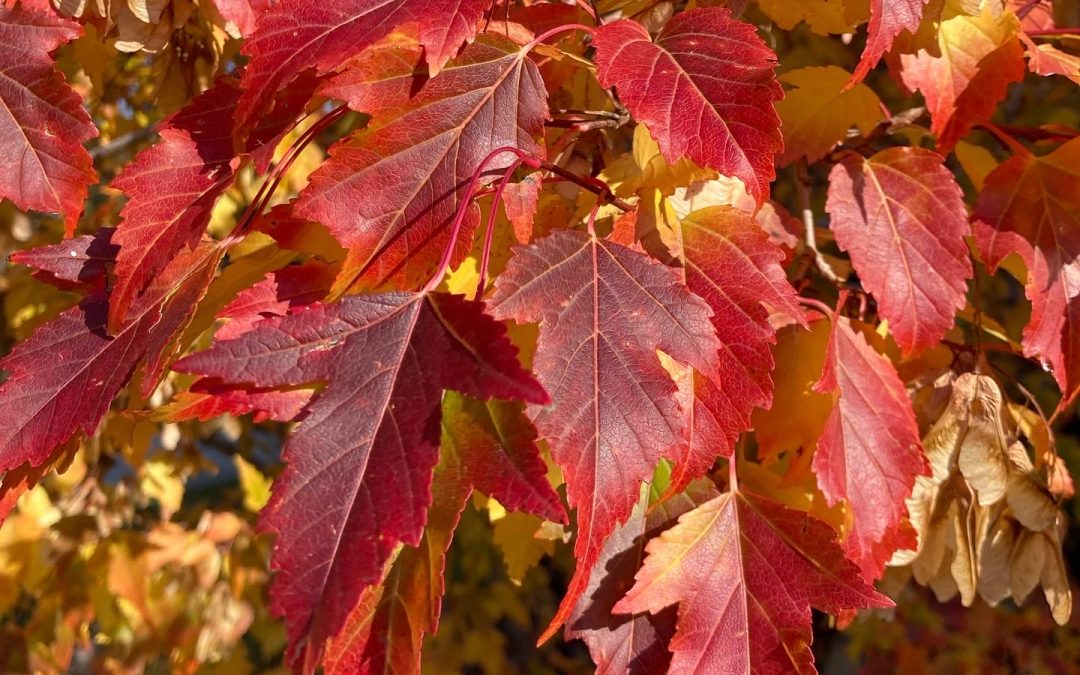I had to remove a tree. It was a sad moment in my life because it is hard to grow trees in Calgary. But it wasn’t all my fault. The people in the house before us wanted a fire pit. So they cut the roots of the 40-year-old tree to create a nice flat space beneath the tree for a fire pit. And that was the beginning of the end.
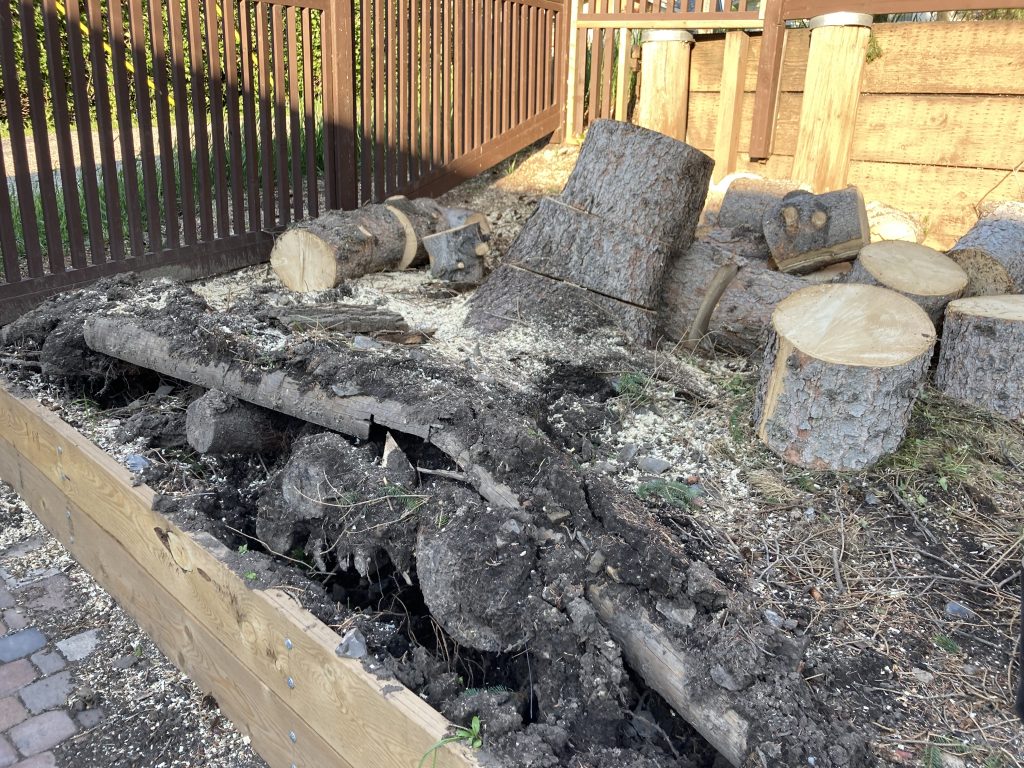
The cleanly cut roots of the spruce tree are exposed once the tree starts to tip over. These cuts, made to create the flat fire pit “area,” meant the anchor roots were shortened or removed. The roots left in place couldn’t hold the weight of the tree during a heavy wind and the tree fell over in almost 100 km winds. The tipping tree was dangerous and what was left of the tree had to be removed.
But let me back up. A spruce tree is a torch waiting to happen. A pine tree is the same. The smallest spark or pitch glob exploding can start a fire. And this is why it is never a good idea to have a fire pit under a spruce tree. In one city, the one where we bought our new house, has clear fire pit rules: “Fire pits must not be under any trees, branches, plants or other materials that can catch fire.“
So simply put: do not install a fire pit under a spruce tree. End of story.
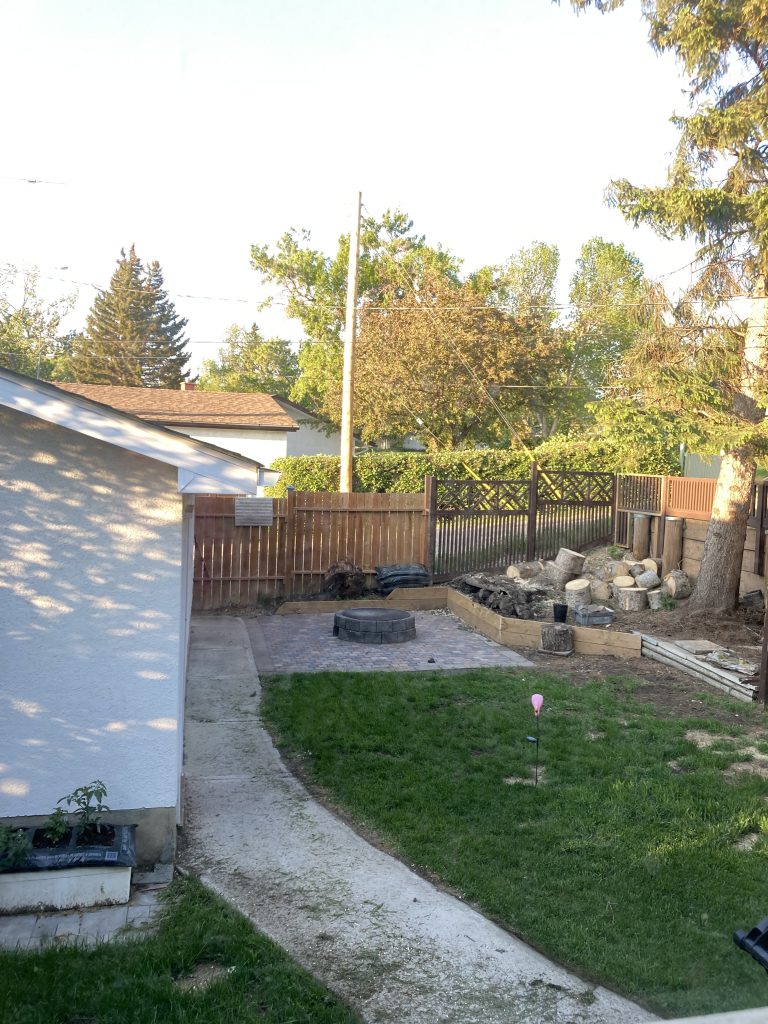
Our fire pit was correctly installed in the centre of a paved area but incorrectly installed under a spruce tree. To make the flat fire pit zone, the anchor roots of the tree were cut. After a big wind, the tree fell over because of the cut roots.
The previous owners removed most of the tree roots to install the fire pit and this damaged the tree, broke a local bylaw, and lead to problems for us when we took possession of the house. The first big (climate related?) winds yanked the tree over. The tree simply tipped over where the roots were cut and before it fell on a neighbour’s property, we had to cut down the tree. A registered consulting arborist confirmed the tree was damaged by the cuts made to create the fire pit and a hands-on certified arborist looked at the tree and the one right beside it. There was nothing to do but remove both trees.
After reading Suzanne Simard’s amazing book, Finding the Mother Tree, I know how trees in the forest and garden connect. When we tried to have the stump ground from the first tree, hoping to somehow ignore the pending demise of the second tree, our arborist reminded us the trees are connected. Remove the roots and stump of one tree and the other tree roots, connected underground, will suffer. I knew that. Suzanne explained all that in her book. But I wanted to pretend we could cut our losses and remove just one tree. But I know better and the advisors I hired know better. And now we are the neighbours who move in and remove trees. Not a good reputation. Even if it is necessary. So now I guess we can have fires in the fire pit. There is no tree overhead to catch on fire but somehow there is no romance in sitting on a piece of pavement in the open roasting a hot dog. So we are choosing a new tree and have ordered a new greenhouse to fill the space left vacant by the near disaster.
Choosing a New Tree
The toughest choice for a gardener in a cold climate is to choose the right tree. Should you go for something blooming in spring like an apple or pear tree? Should you go for fall foliage like an Amur maple? Or maybe you should you go for winter colour like the a mountain ash?

The Amur maple is a small tree with brilliant fall colour. It is a wise choice where space is limited and fall colour is important. But an Amur maple is naked all winter, a period of time that could be 8 months long in Calgary Alberta. If the site is massive and the yard is large, a simple choice would be a spruce or pine tree, because they offer year-round interest.
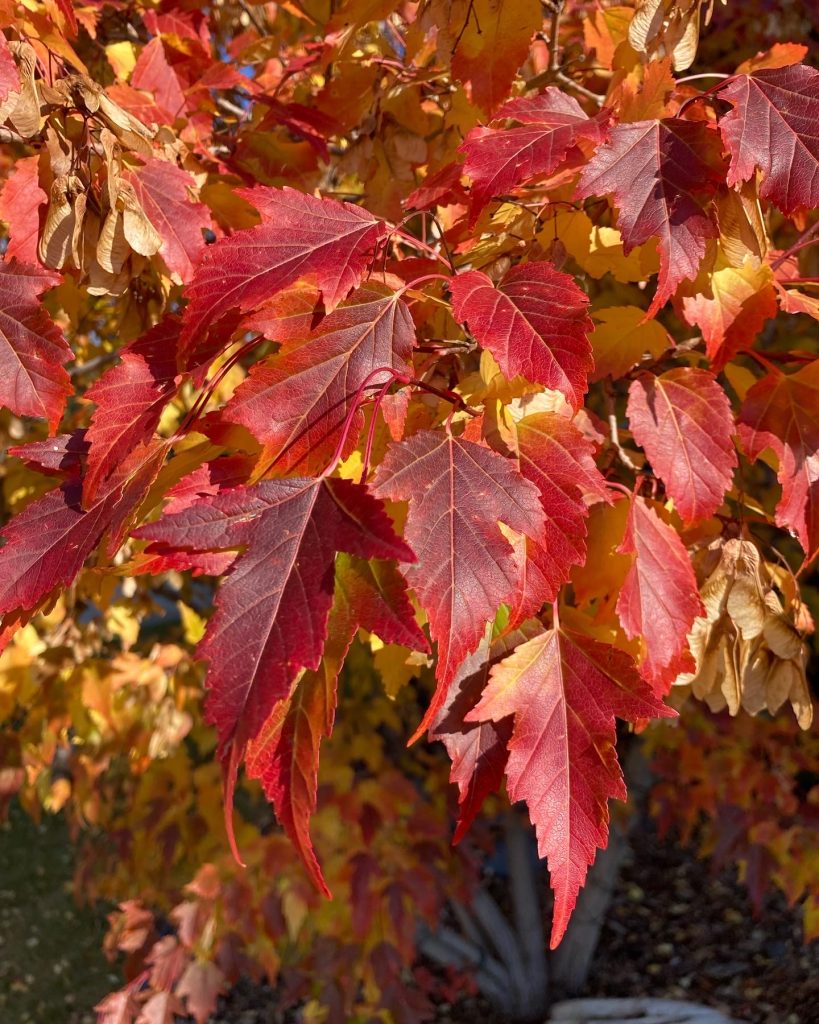
The fall colour of the Amur maple is striking and dramatic.
The only trees that offer year-round colour in Alberta are the conifers. These are the spruce and pine trees that hold their needles for up to seven years. A dwarf version of the Norway Spruce is the Ohlendoorf spruce and I was lucky to find one at a big box store last spring. I bought it and installed it right away but they take years to grow and only reach a 3-4 metre height after a decade or more. Consider all the options available when choosing a new tree, because the tree will grow and it would be nice if the tree lasts as long as your grandchildren.
Changing the Landscape
As I drew my new plan, I decided to change the landscape completely, adding a smaller tree or two plus a greenhouse to create an inviting open space for sitting in cold weather. I chose a Cape Cod design from BC Greenhouse Builders with double doors and a clear glass portion facing into our house and garden. The rest of the greenhouse has polycarbonate on the roof and sides. I will post images when it is built next spring.
This means we will have only a small space for a tree, and we will be better off with a deciduous tree to shade the greenhouse in summer but allow light into the space in spring and fall. Right now I am considering the very beautiful amur maple and the always attractive mountain ash. I am not considering an apple or crabapple because our immediate neighbour in the back alley has one and we will simply borrow his landscape when it is in bloom. This concept of borrowed landscape is very important in an urban landscape, and I encourage it enthusiastically.
My existing greenhouse in my Qualicum Beach garden is a Pacific model and in the summer it is a great backdrop to my sitting area where we eat outdoors and enjoy a variety of blooms and fruits including Amaryllis in August and lemons year-round.
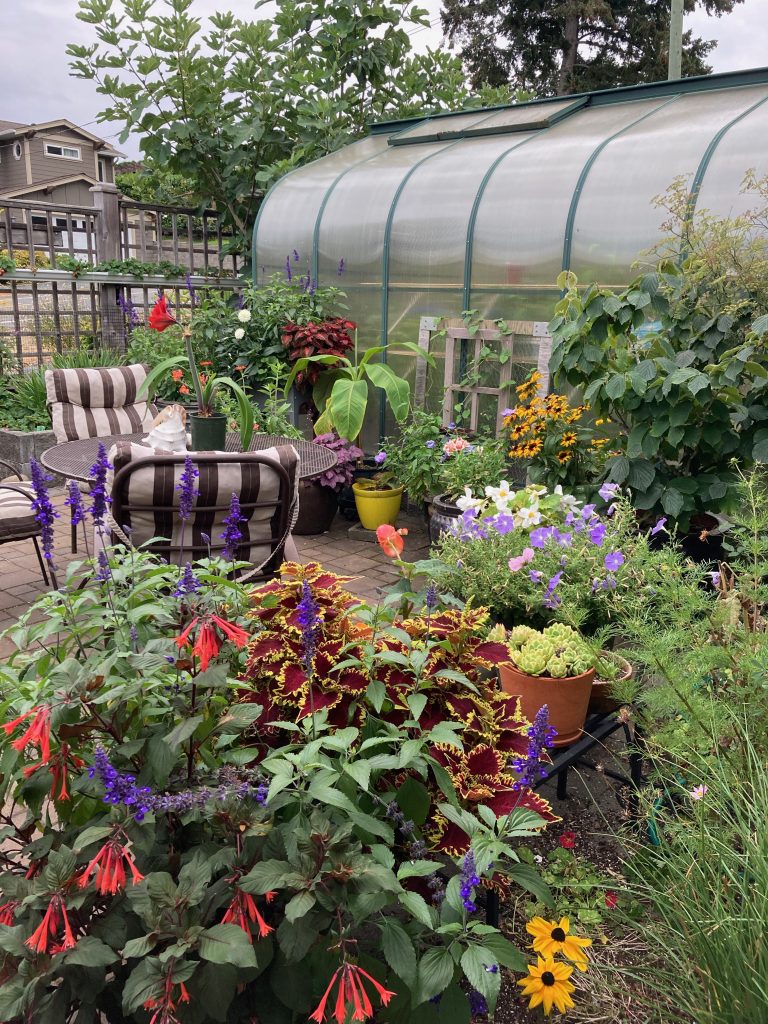
My welcoming back yard includes my current greenhouse where I grow seasonal food year round.
Wood Chips
If you have read my previous accounts of wood chips in the landscape you know they are valuable as a source of mulch and nutrients especially as they break down over time. I had the arborist leave the chips in my yard and this fall I employed my grandson and his friend to move them to fill all my beds before winter hit. I like to use at least 4″ or 8 cm of chips on top of garden soil but some authors will use up to 12 inches or 30 cm. The wood chips hold moisture in the summer so are a great solution to climate change conditions where soil dries out excessively.
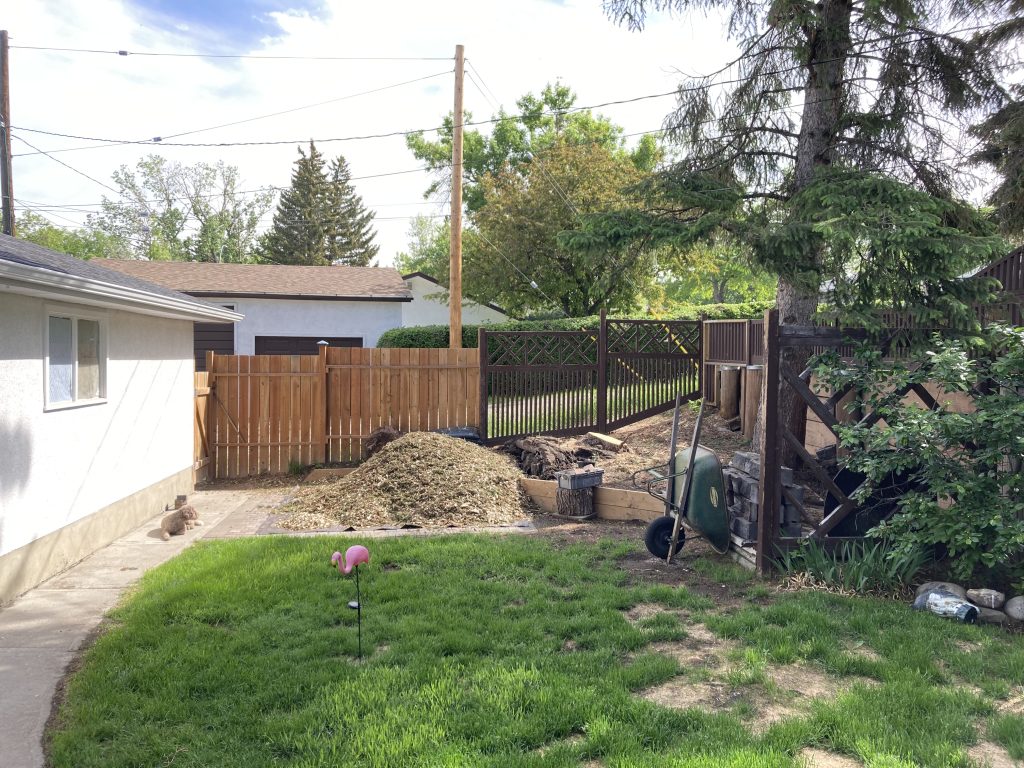
The pile of chips left after my tree was removed was left on a tarp and allowed to decompose for over three summer months. It was steaming at first but then cooled off and was ready to move onto the soil in the rest of my garden.
Lessons Learned
I have learned you can never really “see” what is going on in your yard, especially below ground. And even though I am an experienced gardener I didn’t know my large spruce tree was about to fall down. I do know it is never wise to place a fire pit beneath a spruce tree but now I also know there is a bylaw against this practise and l have a plan in place moving forward.
In fact, we are lucky our tree tipped over because it gave us an opportunity to redesign the landscape more suited to our lifestyle. With a new greenhouse, we’ll have loads of flowers and vegetable seedlings and tomatoes. And I know, in a year or two, the yard will look amazing and the wood mulch will nestle into the soil and give us back the nutrients gathered by the tree we had to remove. Stay tuned for details because I am sure this “new to us” garden will continue to evolve.
